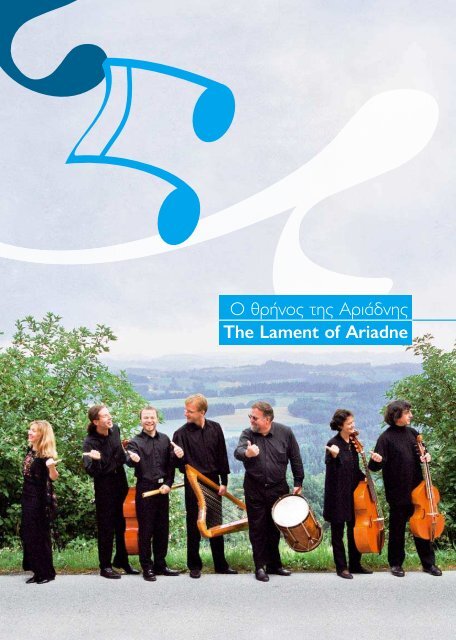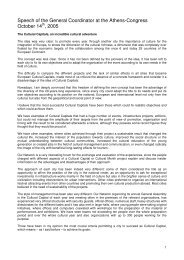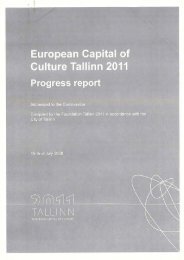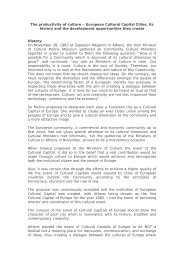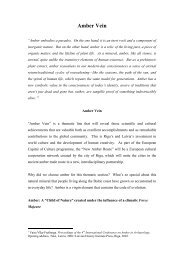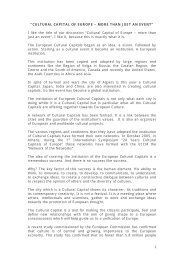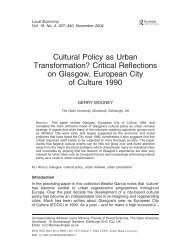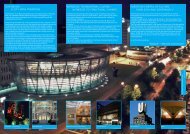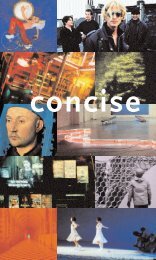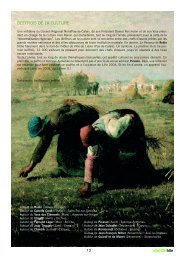patras 2006 - ecoc-doc-athens
patras 2006 - ecoc-doc-athens
patras 2006 - ecoc-doc-athens
You also want an ePaper? Increase the reach of your titles
YUMPU automatically turns print PDFs into web optimized ePapers that Google loves.
Ο θρήνος της Αριάδνης<br />
The Lament of Ariadne<br />
ΜΟΥΣΙΚΗ ΠΑΡΑΣΤΑΣΗ Μαρία Γυπαράκη – Ensemble Accentus:<br />
Ο θρήνος της Αριάδνης<br />
Παραγγελία της Πολιτιστικής Πρωτεύουσας της Ευρώπης – Πάτρα <strong>2006</strong><br />
22, 23 & 24 Μαΐου <strong>2006</strong> Θέατρο Απόλλων<br />
Μουσική ∆ιεύθυνση: Thomas Wimmer<br />
Σκηνοθεσία-∆ραµατουργική Επεξεργασία: Mαρία Γυπαράκη<br />
Σκηνογράφος-Ενδυµατολόγος: Γιώργος Bαφιάς<br />
Κινησιολογία: Nίνα ∆ίπλα<br />
Φωτισµοί: Aντώνης Παναγιωτόπουλος<br />
Video Ιmage: Σπύρος Pασιδάκης<br />
Μπάσο Κοντίνουο: Μάρκελλος Χρυσικόπουλος<br />
Βοηθός Σκηνοθέτη: Γιάννης Ράδος<br />
Βοηθός Σκηνογράφου-Ενδυµατολόγου: Θεοδώρα<br />
Μπανταλούκα<br />
Kατασκευή Σκηνικών: Bασίλης Σακκής<br />
Κατασκευή Κοστουµιών: Χαρά Κοκκίνου<br />
Κατασκευή Πλεκτών: Susana Lighthart<br />
Μάσκες: Βάσω Κασπίρη<br />
Ensemble Accentus,Austria<br />
Cornelia Horak, σοπράνο, Maria Erlacher, σοπράνο, Markus<br />
Forster, άλτο, Gernot Heinrich, τενόρος, Markus Volpert,<br />
µπάσος, Fritz Kircher, µπαρόκ βιολί, Rainer Ullreich, µπαρόκ<br />
βιολί, Jane Achtman, βιόλα ντα γκάµπα, Michael Posch,<br />
πνευστά εποχής, Reinhild Waldek, άρπα, Mάρκελλος<br />
Xρυσικόπουλος, τσέµπαλο, Thomas Wimmer, βιολόνε<br />
Ευχαριστούµε το ΟΜΜΑ για τα κοστούµια.<br />
Η Αριάδνη, κόρη του Mίνωα, παρά τον καταλυτικό της ρόλο<br />
στην εξέλιξη του µύθου του Θησέα, παρέµεινε στην αρχαία<br />
ελληνική γραµµατεία, πρόσωπο αναφοράς και όχι ηρωίδα<br />
δράµατος. Αντιθέτως, η λατινική γραµµατεία και ιδιαίτερα<br />
οι µεγάλοι ποιητές Κάτουλος και Οβίδιος, επαναφέρουν<br />
στο προσκήνιο την εγκαταλελειµµένη στη Νάξο Αριάδνη.<br />
Από τη Ρώµη στην Αναγέννηση, από την Αναγέννηση<br />
στο Μπαρόκ, µέχρι και τη σύγχρονη µουσική δηµιουργία<br />
(Richard Strauss), η δραµατική φιγούρα της Αριάδνης,<br />
δεν έπαυσε να απασχολεί ποιητές, συνθέτες και ζωγράφους.<br />
Η «εγκατάλειψη» και η υπέρτατη «θυσία», θέµατα<br />
ανεξάντλητα καθότι αρχέτυπα σχεδόν «ιερά», ευτύχησαν<br />
να βρουν τον ιδανικό εκφραστή στο πρόσωπο της<br />
µυθικής πριγκίπισσας.∆ιαλέγοντας µερικά από τα πλέον<br />
αντιπροσωπευτικά µουσικά έργα, των οποίων το θέµα<br />
στρέφεται γύρω από την εγκατάλειψη, δηµιουργούµε<br />
µία ολοκληρωµένη σκηνική άποψη, καταστάλαγµα<br />
αισθητικών και δραµατουργικών εµπειριών, πράγµα που<br />
θα δώσει στο σύγχρονο θεατή την ευκαιρία να εκτιµήσει<br />
το «πέρασµα του µύθου» µέσα από τρεις αιώνες θεάτρου,<br />
ποίησης και µουσικής.<br />
Mαρία Γυπαράκη<br />
MUSIC PERFORMANCE Maria Gyparaki – Ensemble Accentus:<br />
The Lament of Ariadne<br />
Commissioned by the European Capital of Culture – Patras <strong>2006</strong><br />
May 22, 23 & 24, <strong>2006</strong> Apollon Theatre<br />
14<br />
15<br />
Music Direction: Thomas Wimmer<br />
Director-Dramatic Adaptation: Maria Gyparaki<br />
Stage-Costume Designer: Giorgos Vafias<br />
Movement: Nina Dipla<br />
Lighting: Antonis Panagiotopoulos<br />
Video Image: Spyros Rassidakis<br />
Basso Continuo: Markellos Chryssikopoulos<br />
Assistant Director: Yianis Rados<br />
Stage-Costume Designer’s Assistant: Theodora Bandalouka<br />
Set Construction: Vassilis Sakkis<br />
Costume Construction: Hara Kokkinou<br />
Knitware: Susana Lighthart<br />
Masks: Vasso Kaspiri<br />
Ensemble Accentus,Austria<br />
Cornelia Horak, soprano, Maria Erlacher, soprano, Markus<br />
Forster, alto, Gernot Heinrich, tenor, Markus Volpert, basse,<br />
Fritz Kircher, baroqueviolin, Rainer Ullreich, baroqueviolin,<br />
Jane Achtman, viola da gamba, Michael Posch, recorders,<br />
Reinhild Waldek, tripleharp, Markellos Chryssikopoulos,<br />
harpsichord, Thomas Wimmer, violone<br />
With compliments to OMMA for the costumes.<br />
Ariadne, daughter of Minos, despite her catalytic role<br />
in the development of the myth of Theseus, remained,<br />
for the ancient Greek literature, not as drama heroine<br />
but only as one who is simply referred to. By contrast, Latin<br />
literature and especially the great poets Catullus and Ovid,<br />
bring the abandoned in Naxos Ariadne back on the<br />
forestage. From Rome to the Renaissance, from the<br />
Renaissance to the Baroque to contemporary music<br />
creation (Richard Strauss), the dramatic figure of Ariadne<br />
has not ceased to inspire poets, composers and painters.<br />
The ‘abandonment’ and the ultimate ‘sacrifice’, are<br />
inexhaustible themes precisely because they are archetypal,<br />
almost ‘sacred’, and were ‘blessed’ into finding their ideal<br />
expression in the persona of the mythical princess.<br />
By choosing three of the most representative musical<br />
works, whose subject matter is the issue of abandonment,<br />
we are creating a comprehensive stage vision, an amalgam<br />
of aesthetic and dramaturgic experiences, which will offer<br />
the contemporary spectator the opportunity to appreciate<br />
the ‘passage of myth’ through three centuries of theatre,<br />
music and poetry.<br />
Maria Gyparaki


